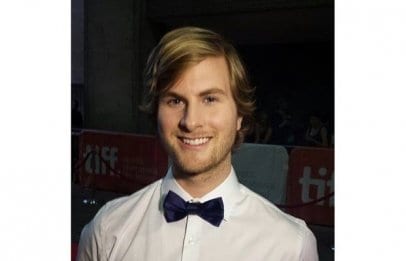I experienced TIFF at full force this year.
Covering the TIFF red carpet premieres for Daily Xtra was a complete blast — in more than one way. Now that they’ve come to an end, it’s time to share what I learned from my glimpse of the glamorous life.
1) Actually, red carpets aren’t that glamorous
In reality, covering red-carpet premieres is quite stressful.
Each red carpet isn’t confirmed until the day of. When you show up more than an hour early, you find your number and squeeze into your spot along the carpet. Unfortunately, we aren’t all as skinny as the stars we interview.
Sometimes the carpets aren’t too hectic, like when there are only 10 camera crews. But when there are 60 in that same space, even breathing is a stretch.
And don’t expect the talent to arrive on time. They might show up an hour late and, in that case, only have a few minutes to spare for the media.
2) Be bold or back off
When a celebrity is coming down the red carpet, they’ll spend a lot of time with the big media crews at the front of the line.
If you’re anywhere from the middle to end, they might have time for only one quick question before a PR person literally pulls them away.
To save time, reporters often get grouped together. On the red carpet of Foxcatcher, we were limited to one question per group. This is where it paid off to make friends with the people beside us so we could coordinate questions and all get something we could work with.
We got grouped with about seven other reporters for the big stars of The Imitation Game. Luckily, Benedict Cumberbatch and Keira Knightley were incredible. They answered question after question until the inevitable tugging from the PR crew.
It takes courage to raise your voice in a crowd and ask a question of celebrities as striking as Cumberbatch and Knightley. But if you aren’t willing to do it, step back and let one of the many hungry reporters take your place.
3) I’m the “dumbest interviewer of 2014”
So I got blasted on the internet because of my interview with James Franco at the premiere of his film The Sound and The Fury. Let me explain.
Franco has a huge gay following, and most of his recent work involves gay content. He intrigues us, whether he’s co-directing films like Interior. Leather Bar, a film inspired by footage cut from Cruising, a 1980 classic about a serial killer targeting gay men, or making us cry from laughter with his pretend gay skits with Seth Rogen.
This is why we decided to ask him something relevant to our audience, something different from what every other media outlet was asking.
We knew “What draws you to gay culture? It almost seems like a fetish of yours” wasn’t going to be as easy to answer as “Why did you make this film?” But why softball someone when we have only one question with them? We wanted to ask something we actually wanted to know.
Of course he was there to talk about The Sound and The Fury, but we’ve requested to speak with him multiple times and got nowhere. We genuinely thought he would respond with the fun presence he often projects.
Wrong. We got shut down.
Then the Toronto Star wrote about the question in a story where Franco called it “crap” and “bullshit.”
When I looked at the video on our YouTube channel, I saw a hurricane of hate. Apparently that question made me a “clown show, dumbass and unprofessional scumbag.”
Apparently we were out of line using the word “fetish.” Okay, I get that some fetishes are pretty out there. But what’s wrong with using the word in the context that we did?
4) Only read the negative comments for comedic value
Reading hate-filled comments about yourself isn’t easy. But at the end of the day, who really cares what “cherrydog9” and “twaadaa” have to say?
The best these comments can provide is a good laugh. That’s it.
5) I gained confidence
Honestly, I was pretty nervous at the first red-carpet premiere we covered. I’m from Winnipeg and I can’t recall seeing a red carpet in person before coming to Toronto, never mind the celebrities that strut along them.
Here I was, face to face with stars like Al Pacino, James Franco, Steve Carell, Benedict Cumberbatch and Keira Knightley, and I managed to stay on my feet.
I’ve learned from every interview; it always amazes me how much one can grow when one ventures outside one’s comfort zone.
My passion for becoming a great interviewer has only increased from this experience. I guess, in a sense, you could even call it a fetish of mine.

 Why you can trust Xtra
Why you can trust Xtra


